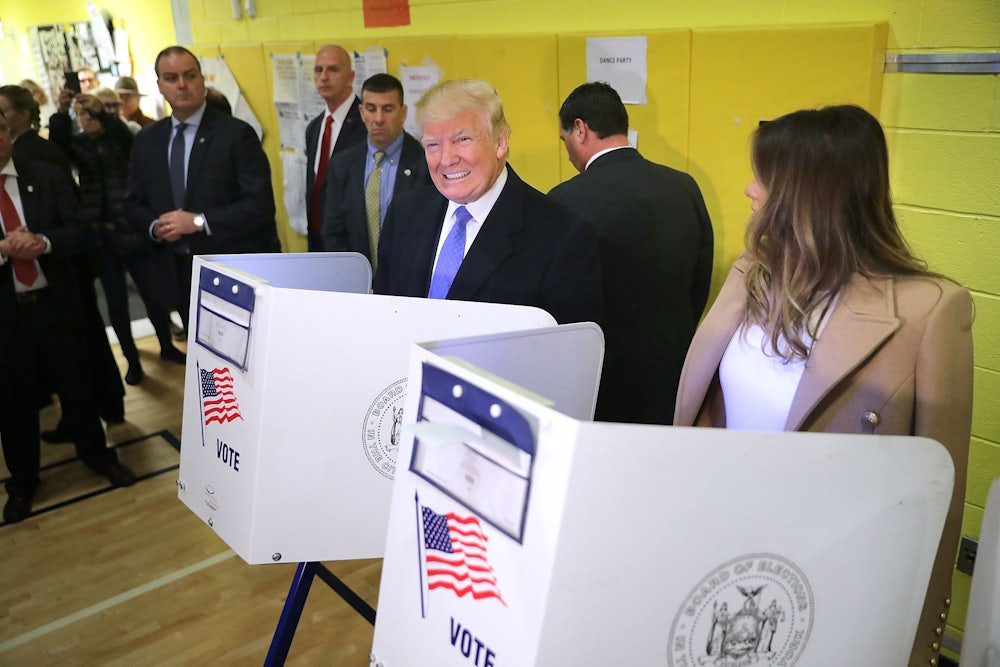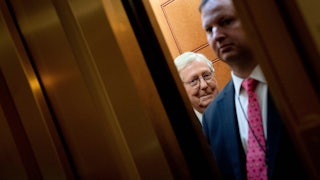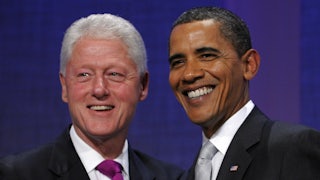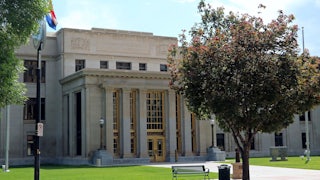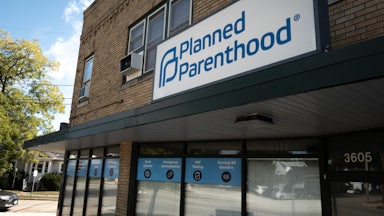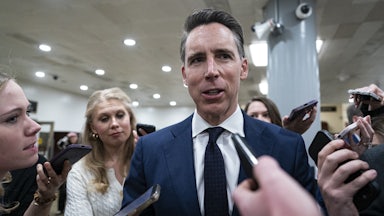The publication by Politico’s Josh Gerstein and Alexander Ward of Justice Samuel Alito’s February draft decision overturning Roe v. Wade and Planned Parenthood v. Casey confirms the reactionary nature of the current Supreme Court majority. The salient fact about this majority isn’t that it’s a Republican-appointed majority. It’s that it’s an Electoral College majority.
It took an Electoral College Court—a high court whose composition defies popular vote majorities in two presidential elections—to overturn Roe. And though Mr. Dooley famously observed that “th supreme coort follows th’ iliction returns” rather than “th’ constitution,” Peter Finley Dunne’s fictional Irish bartender never anticipated a Supreme Court so smugly indifferent as this one to the will of the popular majority.
Mr. Dooley’s truism about the Supreme Court, I must confess, never made a lot of sense to me. Even back in the days when the high court’s legitimacy was buttressed by nominations from popular vote–winning presidents, plenty of Supreme Court justices frustrated the expectations of those presidents.
The most extreme example in recent history was Earl Warren, who defied President Dwight Eisenhower’s wishes by joining the majority in Brown v. Board of Education and then proceeding to issue a string of liberal decisions. This was a man who, when he ran successfully for governor in 1942, pledged that his first act would be to fire the state chief of immigration and housing, Carey McWilliams, who three years earlier had annoyed California growers by writing Factories in the Field (still the most authoritative account ever written of California farm labor). Warren carried out his threat. No wonder Eisenhower thought him a safe choice. But Warren changed.
In more subtle ways, Justices Anthony Kennedy and Sandra Day O’Connor defied the expectations of President Ronald Reagan by becoming swing voters. Then George H.W. Bush placed on the court both David Souter and Clarence Thomas, who migrated further leftward and rightward, respectively, than Poppy likely wished.
In all these instances, the Supreme Court did not follow the election returns. True, the court drifted rightward after President Richard Nixon established a Republican majority in 1970. But it didn’t act in lockstep with the presidents who populated it. Individual justices remained somewhat unpredictable in their jurisprudential trajectories.
Those days are over. Today, Supreme Court justices follow the election returns in the narrow sense that they more predictably vote as the presidents who appointed them intended. But in a broader sense, the Supreme Court is linked more weakly than ever to the election returns because the presidencies that installed most of its members didn’t follow the election returns.
This is most glaring for the three justices nominated by President Donald Trump. Trump lost the popular vote in both 2016 and 2020, yet managed to get Neil Gorsuch, Brett Kavanaugh, and Amy Coney Barrett onto the Supreme Court because he won the Electoral College in 2016. No one-term president had put that many justices onto the Supreme Court since Herbert Hoover.
The democratic legitimacy of Gorsuch and Barrett gets shakier when you remember the circumstances of their confirmations. The Republican Senate confirmed Gorsuch only after refusing to consider Democratic President Barack Obama’s nomination of Merrick Garland on the bogus grounds that a presidential election was too imminent (it was eight months away). Then, cheerfully contradicting itself, the Republican Senate rushed through Trump’s nomination of Barrett after mail-in balloting had already started in the 2020 presidential election.
The presidents denied the chance to fill these two high court vacancies, Obama and Joe Biden, both won popular vote majorities. Trump did not. He couldn’t cobble together even a popular vote plurality. (Trump won 46.2 percent to Hillary Clinton’s 48.2 percent in 2016 and 46.9 percent to Biden’s 51.3 percent in 2020.)
In addition to Gorsuch, Kavanaugh, and Barrett, two other members of the Supreme Court’s Electoral College majority are Justice Samuel Alito, author of the infamous draft ruling on Dobbs v. Jackson Women’s Health Organization, and Chief Justice John Roberts. Their democratic legitimacy isn’t as dubious as that of the Trump appointees, because they were nominated by President George W. Bush after he won the 2004 election with a popular vote majority (50.7 percent to John Kerry’s 48.3 percent). But given the narrowness of that victory, it seems doubtful Bush could have won in 2004 without the advantage of incumbency. That incumbency was secured in 2000, when Bush won the Electoral College but lost the popular vote to Al Gore, 47.9–48.4 percent.
In that election, the Supreme Court didn’t follow the election returns; it determined them by ruling Bush the Electoral College winner in a decision whose legal reasoning even Republicans don’t like to defend. (For the record, I’m persuaded that Bush really did win the Electoral College majority. I never could get terribly enthusiastic back in 2000 about overcounts and hanging chads and butterfly ballots. Then, as now, I preferred to inveigh against the lunacy of the Electoral College itself.)
Of the five justices reportedly signed on to Alito’s draft ruling on Dobbs, four (Gorsuch, Kavanaugh, Barrett, and Alito himself) are Electoral College justices. Without these four, Clarence Thomas would be the only Supreme Court justice willing to overturn Roe. (The fifth Electoral College justice, Chief Justice John Roberts, reportedly prefers a partial rollback of Roe and is unlikely to join Alito’s decision without significant and unlikely concessions.) You want to blame somebody for this social catastrophe? Blame the Electoral College.
Don’t get me wrong. I’m not questioning the legal basis for overturning Roe. I’m not a lawyer, and not much of a legal expert. But I am a small-d democrat. That makes it hard for me to ignore that women are about to lose their right to an abortion because four justices were installed by two presidents who got to the White House without winning more votes than the other person—and two of those four justices sit on the bench as a result of outrageous partisan maneuvering in the Senate. Nobody who voted in the 2000 or 2016 presidential elections gets a say in this momentous change.
One underappreciated irony here is that Roe was a Republican decision. The justice who in 1970 gave Republicans the Supreme Court majority they’ve enjoyed ever since, Harry Blackmun, is also the justice who wrote the 1973 Roe decision. He was joined by four Republican-appointed justices (William Brennan, Lewis Powell, Potter Stewart, and Chief Justice Warren Burger) and two Democratic-appointed justices (William O. Douglass and Thurgood Marshall). One Democratic-appointed justice (Byron White) and one Republican-appointed justice (William Rehnquist) dissented. The partisan line on abortion between Democrats and Republicans wasn’t as clear as it is today, but even so it’s striking that Roe was the work mostly of Republican appointees. They didn’t follow the election returns.
But actually they sort of did, perhaps in a broader sense that Mr. Dooley was trying to communicate. They understood that they lived in a society that was demanding equal rights for women and greater sexual freedom. Even Roe’s defenders seldom argue it’s a well-crafted legal decision, but it met the moment. The current Supreme Court majority feels no comparable regard for public opinion, because it’s dominated by ideologues.
If we want the Supreme Court to care about what our society demands, we’ll need to get rid of the Electoral College and elect presidents through the more recognizably democratic popular vote. I won’t repeat the arguments—I last made them here—because by now I think it’s pretty well understood that an antiquated system dating back to the Holy Roman Empire is a lousy tool to elect presidents. (Even Donald Trump has knocked it.) What Alito’s draft decision overturning Roe demonstrates is that the Electoral College is a bad fit for a modern judiciary too.
